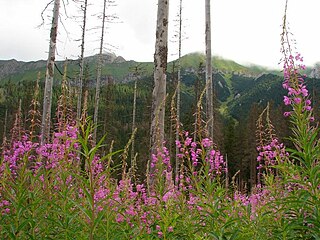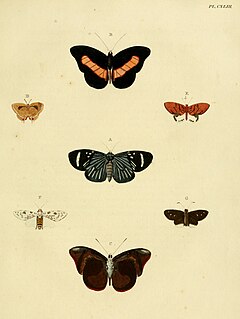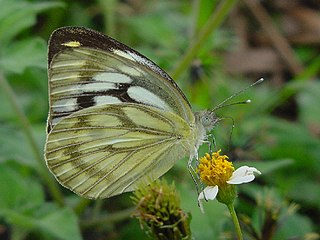
A woodland, in the broad sense, is land covered with trees or, in a narrow sense, synonymous with wood, is a low-density forest forming open habitats with plenty of sunlight and limited shade. Woodlands may support an understory of shrubs and herbaceous plants including grasses. Woodland may form a transition to shrubland under drier conditions or during early stages of primary or secondary succession. Higher density areas of trees with a largely closed canopy that provides extensive and nearly continuous shade are often referred to as forests.
A bioregion is an ecologically and geographically defined area that is smaller than an ecozone, but larger than an ecoregion or an ecosystem, in the World Wildlife Fund classification scheme. There is also an attempt to use the term in a rank-less generalist sense, similar to the terms "biogeographic area" or "biogeographic unit".

Spalgis epius, the apefly, is a small butterfly found in the Indomalayan realm that belongs to the lycaenids or blues family. It gets its name from the supposed resemblance of its pupa to the face of an ape.

Miletinae is a subfamily of the family Lycaenidae of butterflies, commonly called harvesters and woolly legs, and virtually unique among butterflies in having predatory larvae. Miletinae are entirely aphytophagous. The ecology of the Miletinae is little understood, but adults and larvae live in association with ants, and most known species feed on Hemiptera, though some, like Liphyra, feed on the ants themselves. The butterflies, ants, and hemipterans, in some cases, seem to have complex symbiotic relationships benefiting all.

Notocrypta is a genus of skipper butterflies. It is one of several closely related genera commonly called "demons". The genus is found in the Australasian ecozone and the Indomalaya ecozone.

The Lecithoceridae, or long-horned moths, are a family of small moths described by Simon Le Marchand in 1947. Although lecithocerids are found throughout the world, the great majority are found in the Indomalaya ecozone and the southern part of the Palaearctic ecozone.

The Cochylini are a tribe of tortrix moths. It used to be classified as the subfamily Cochylinae.

Amblypodia is a genus of butterflies in the family Lycaenidae. Several species formerly placed here are now in Arhopala and Flos, although this placement is not necessarily definite.

Ancema is a butterfly genus in the family Lycaenidae. The species of this genus are found in the Indomalaya ecozone and the Palearctic ecozone.

Anthene is a genus of butterflies in the family Lycaenidae, commonly called the ciliate blues or hairtails. The genus was erected by Edward Doubleday in 1847.

Artipe is a genus of butterflies in the family Lycaenidae. The species of this genus are found in the Indomalaya ecozone, the Palearctic ecozone and the Australasian ecozone.

Logania is a genus of butterflies in the family Lycaenidae.

Megisba is a genus of butterflies in the family Lycaenidae.
The Montane Cordillera Ecozone, as defined by the Commission for Environmental Cooperation (CEC), is an ecozone in south-central British Columbia and southwestern Alberta, Canada. A rugged and mountainous ecozone spanning 473,000 square kilometres, it still contains "two of the few significant agricultural areas of the province", the Creston Valley and the Okanagan Valley. Primarily a mountainous region, it consists of rugged ecosystems such as alpine tundra, dry sagebrush and dense conifer forests. The interior plains are encircled by a ring of mountains. The area has a mild climate throughout the year, with typically dry summers and wet winters.
The Boreal Cordillera Ecozone, as defined by the Commission for Environmental Cooperation (CEC), is a Canadian terrestrial ecozone occupying most of the northern third of British Columbia and southern half of the Yukon. Within it is found Kluane National Park and Reserve, and a small portion of the southern range of Nahanni National Park Reserve. Most of the area's population is based in the city of Whitehorse, and it contains most of the Yukon's population. The portion in British Columbia is barely populated.

Niphanda is a genus of butterflies in the family Lycaenidae and only member of the Niphandini tribe. The members (species) of this genus are found in the Indomalaya ecozone and the Palearctic ecozone. The genus was erected by Frederic Moore in 1875.

Cephrenes is a genus of skipper butterflies in the family Hesperiidae. The genus is shared between the Indomalayan ecozone and the Australasian ecozone. Larvae feed on a variety of palms (Arecaceae) especially Cocos nucifera (coconut), and Calamus (rattan).

Cepora is a genus of butterflies, commonly called gulls, in the family Pieridae. The genus contains about 20 species shared between the Indomalayan ecozone and the Australasian ecozone.
Spalgis jacksoni is a butterfly in the family Lycaenidae. It is found in Uganda and Tanzania.

Spalgis lemolea, the lemolea harvester or African apefly, is a butterfly in the family Lycaenidae. The species was first described by Hamilton Herbert Druce in 1890. It is found in Senegal, the Gambia, Guinea-Bissau, Guinea, Liberia, Ivory Coast, Ghana, Togo, Nigeria, Cameroon, from Gabon to Ethiopia, the Democratic Republic of the Congo, Uganda, Kenya, Malawi, Zambia, northern Zimbabwe and Botswana. The habitat consists of forests and dense savannah, as well as thick riverine bush.















